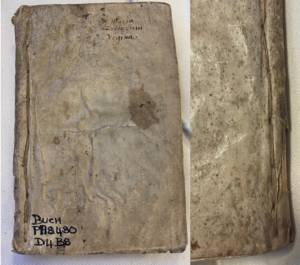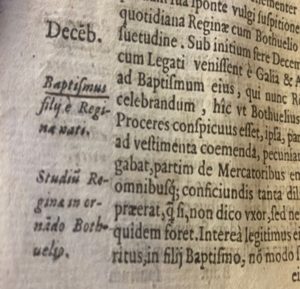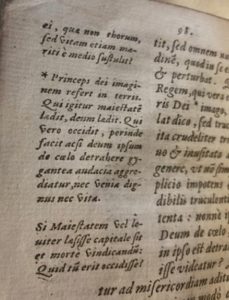De Maria Scotorum regina (1571)

We are delighted that students on Dr Amy Blakeway’s ‘Mary Queen of Scots, France, England and Ireland’ module (MO4807) have once again submitted blog posts as part of their course. Here is the next part of a small series of blogs which reflect on the rare books with which the students engaged during their studies.
Printed in London by John Day, with no author named on the title page, De Maria Scotorum regina (1571) forms part of the attempt by the Elizabethan propaganda machine led by William Cecil, Elizabeth I’s closest adviser, to present Mary Stewart as an unsuitable candidate for the English throne.[1] By 1571, Mary, Queen of Scots was deposed and imprisoned in England, with her young son, James VI on the throne of Scotland, supported by many of the Scottish nobility who had opposed his mother. This included George Buchanan, tutor to the young king, whose original words in the Detectio this text uses. This was composed as evidence against the Scottish Queen for the York-Westminster Conference in 1568, and extended by Thomas Wilson, another of Elizabeth’s advisers, to construct a guise of a Scottish-produced indictment. The choice to publish in 1571 was prompted by increased international intrigue surrounding Mary, that aimed to present her as a Catholic alternative to the Protestant Elizabeth.

This copy has a limp vellum binding and original stitching through the inner-margins of the text, which was often cheap and temporary.[2] This was designed to be widely and inconspicuously circulated: small, thin and portable. This was used by William Cecil to continue the Elizabethan policy of neutrality against Mary whilst covertly destroying her reputation and rendering her an unsuitable candidate for rule.
Unique to the Latin publication, despite being published alongside pseudo-Scots and French versions, is the extensive use of marginal notes to frame the reader’s response to the text. This only appears in the pseudo-Scots version once in a fact-stating capacity and takes two forms in the De Maria: temporal (marking out a timeline of events) and commentary (suggestive comments to frame interpretation). The use of temporal headings clearly signpost the narrative sequence of events to add legitimacy to the text as a ‘history’, but this also adds to the sense of this text as a ‘trial’, as Tricia McElroy has highlighted in the printed form of Ane Detectioun.[3] Like clerk markings in court records, this weaponises the tract as an easily accessible set of arguments against Mary. Whilst historians have focused on Mary’s gender, these marginal notes show readers that contemporaries were concerned with different facets of the argument against the Scottish Queen, and are a text in themselves.

George Buchanan, Ane Detectioun of the Duinges of Marie Quene of Scottes (London: 1571), Buch DA787.A3B8

Though the Detectio has been dismissed as ‘based wholly on the demerits of the Queen’s personal character’, the notes portray a contractual monarchy and suggest Mary’s deposition is legitimate because she has failed as King.[4] She is shown causing ‘dissention among nobles’ and ‘stirring bitter disputes’, because she is fundamentally untrustworthy. As ‘Queen of Disguise and Treachery’, she ‘prostitutes her honour’ and with it, the honour of Scotland.[5] It is also suggested that Mary did not execute justice properly, a fundamental quality of Kingship. After the death of her husband, Henry, Lord Darnley, there was ‘scarcely any question or investigation’ and Mary held a ‘simulated trial with counterfeit denunciations’, mocking justice in contrast to the ‘just protests’ of the nobility.[6] This is reinforced by the emphasis that Mary’s ‘open’ actions in the aftermath of his murder reflected badly on Scotland as a country: ‘the English and French ambassadors [are] witnesses to the joy of the Queen’ and there is emphasis on ‘rumours […] everywhere’.[7] Foreign ambassadors as ‘witnesses’ adds to the idea of the text as a trial, with Mary’s people becoming her jury when the common women condemn their queen when the ‘words of women shout out against’ her.[8] Indeed, Wilson’s appended comments in the Actio, adds to this indictment of monarchy, reinforcing the fact that ‘there is no evidence […] more serious than the public silence of the people’.
Ultimately, De Maria shows that the material culture of anti-Marian propaganda is important for a full assessment of the rhetorical strategies used against Mary. We need to look at how people printed their arguments, as well as what they said, to provide a full picture of the contemporary case against Mary, Queen of Scots.
Olivia Dunderdale
[1] George Buchanan, De Maria Scotorum regina, (London: 1571), University of St Andrews Library, Buch PA8480.D4B8, [All translations are my own]
[2] Mirjam M. Foot, ‘Bookbinding’ in D.F. McKenzie and Maureen Bell (eds.), The Cambridge History of the Book in Britain, IV, (Cambridge: 2002), p.621
[3] Tricia McElroy, ‘Performance, Print and Politics in George Buchanan’s Ane Detectioun of the Duinges of Marie Quene of Scottes’ in Caroline Erskine and Roger Mason (eds.), George Buchanan: Political Thought in Early Modern Britain and Europe, (Farnham: 2012), p.50
[4] W.A. Gatherer, The Tyrannous Reign of Mary Stewart, (Edinburgh: 1978), p.35
[5] Regina dissimulation et persidia; honore suum simul et consentiam prostituit, De Maria, p.108, 116
[6] Vix vlla quaestio aut peruestigatio; Iudicium simulatis edictis fucatum; Protestatio iudicium, ibid, p.21
[7] Anglus et Gallus duo legati, Letitia Regina testes; Rumores passim dissipate, ibid, p.87, 22
[8] Verba cuiusdam foeminae contra regina exclamatis; Contra Reginam nullu grauius testimonium quam publicium populi silentium, ibid, p.92
Bibliography:
Works Assessed –
Buchanan, George, De Maria Scotorum regina, (London: 1571), University of St Andrews Library, Buch PA8480.D4B8
Primary –
Buchanan, George, Ane Detectioun of the Duinges of Marie Quene of Scottes, (London: 1571), University of St Andrews Library, Buch DA787.A3B8
Secondary –
Foot, Mirjam M., ‘Bookbinding’ in John Barnard, D.F. McKenzie and Maureen Bell (eds.), The Cambridge History of the Book in Britain, Vol.4, (Cambridge: 2002), pp.620-631
Halsall, Paul (ed.), Fordham University Internet Ancient History Sourcebook, <https://sourcebooks.fordham.edu/ancient/tomyris.asp>, Accessed 26 March 2022
Gatherer, W.A. (ed.), The Tyrannous Reign of Mary Stewart, (Edinburgh: 1978)
McElroy, Tricia, ‘Performance, Print and Politics in George Buchanan’s Ane Detectioun of the Duinges of Marie Quene of Scottes’ in Caroline Erskine and Roger Mason (eds.), George Buchanan: Political Thought in Early Modern Britain and Europe, (Farnham: 2012), pp.49-70
Warnicke, Retha, Mary Queen of Scots, (Abingdon: 2006)